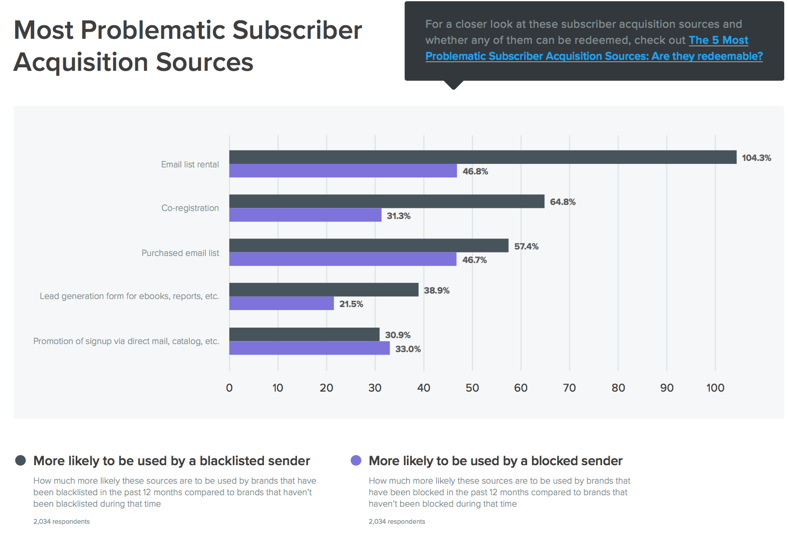Purchased Lists
Filters working as intended
One of the toughest deliverability problems to deal with is when mail is blocked or going to spam because the filters are working as intended. Often the underlying issue is a lack of permission.
Read MoreEvolution of policy
Last week, I talked about policy, using some different blocklist policies as examples. In that post I talked about how important it is that policy evolve. One example of that is how we’ve been evolving policy related to companies that get listed on Purchased Lists and ESPs. Who is listed has evolved over time, and we’re actually looking at some policy changes right now.
Read MoreState of Email Deliverability
I had other posts in the pipeline, but saw a link to the Litmus 2017 State of Email Deliverability Report and decided that deserved a mention here.
There’s all sorts of interesting data there, and well worth a download and read. I was, of course, interested in the “most problematic subscriber acquisition sources.” Senders having blocking issues or blacklist problems in the past 12 months use list rental, co-reg and purchased lists more often than senders that didn’t have problems.
Senders acquiring addresses through list rental are 104% more likely to be blacklisted than senders not using list rental. And they’re 47% more likely to be blocked.
These stats are the primary reason that most ESPs don’t allow list rentals, purchased or co-reg lists. They cause blocking and blacklisting. The ESP ends up having to deal with lots of problems and clean up the mess.
I’m unsurprised that lead generation by giving something away (a report, ebook, whatever) is related to problems. Most of these forms do little to no data checking and accept any and all fake data. There are fairly simple ways to enforce better data, but that does limit the spread of the information.
I am surprised to see signup through direct mail and catalog sales is so bad. Unless maybe people don’t know how to say no when asked for an email address over the phone. I know it seems awkward to say no when asked for an email address. Maybe some folks are giving fake addresses. I sometimes say I don’t have email, or just tell them no, they don’t need one.
The white paper itself is well worth a read. Go download it yourself (but don’t give them a fake email address!).
Engagement drives deliverability
Return Path released an white paper today offering the Secrets of Successful Senders. I don’t think any of my readers will be surprised that it boils down to identity, reputation, and engagement. Return Path treats these as separate things and I understand why they do. I think however, that the identity and reputation are supporting players to the overarching issue of engagement.
When I’m dealing with clients and troubleshooting deliverability problems and offering solutions, I focus on the root cause. To me the root cause is almost always a data problem. Either there’s a problem with data collection or there’s a problem with data maintenance. These problems result in mail going to people who don’t really want or care about it.
Yes, identity is important. But, realistically, anyone mailing through a decent ESP has SPF and DKIM in place, at least on some level. There may be better ways to authenticate, but the boxes are checked.
Yes, reputation is important. But here’s the thing, reputation just means that the ISP knows how users are going to react to an email. Reputation isn’t some nebulous concept made up by ISPs. It’s an actual measurement. It quantifies the history of an IP or a domain or a mail stream and says we know that this IP sends wanted mail. We know that this domain sends mail our users ignore. It’s a history. Past performance does indicate future results.
Identity says who a sender is. Reputation tells us that sender’s history of sending. Those are the two factors that enable ISPs to make delivery decisions. Mail comes in and the ISP looks at it. They use identity to determine what reputation to assign to a mail. Reputation drives delivery, whether into the inbox or the bulk folder.
Purchased lists aren't always purchased
Spamhaus has listed a number of domains belonging to French politicians recently. In their blog post about it, they mention that the listings are directly related to address lists provided to candidates by the French government.
Read MoreGmail filtering in a nutshell
Gmail’s approach to filtering; as described by one of the old timers. This person was dealing with network abuse back when I was still slinging DNA around as my job and just reading headers as a hobby.
Read MoreAbout that permission thing
I wrote a few days ago about permission and how it was the key to getting into the inbox. It’s another one of those “necessary but not sufficient” parts of delivery. There are, however, a lot of companies who are using email without the recipient permission. These companies often contact me to help them solve their delivery problems. Often these are new companies who are trying to jumpstart their business on the cheap by using email.
The calls have a consistent pattern.
May 2016: The Month in Email
Summer, already? Happy June! Here’s a look at our busy month of May.
I had a wonderful time in Atlanta at the Salesforce Connections 2016 conference, where I spoke on a panel about deliverability. While in Atlanta, I also visited our friends at Mailchimp, and later spoke at the Email Innovations conference in Las Vegas, where I did my best to avoid “explaining all the things”. Since my speaking schedule for 2017 is filling up already, I’m sure I’ll have plenty of opportunity to explain many more of the things over the next year or so. Let me know if there’s an event that might be a good fit for me, either as a keynote speaker or on a panel.
Steve contributed a few technical posts on the blog this month. He mentioned that Google has stopped supporting the obsolete SSLv3 and RC4, and he explored the ARC protocol, which is in development and review, and which will be useful in extending authentication through the email forwarding process.
Meri contributed to the blog this month as well, with a post on the Sanders campaign mailing list signup process. We’ve written about best practices for political campaigns before, and it’s always interesting to see what candidates are doing correctly and incorrectly with gathering addresses and reaching out to supporters.
In other best practices coverage, I pointed to some advice for marketers about authentication that I’d written up for the Only Influencers list, a really valuable community for email marketers. I wrote about purchased lists again (here’s a handy collection of all of my posts on the topic, just in case you need to convince a colleague that this isn’t a great idea). I also wrote about how getting the technical bits right isn’t always sufficient, which is also something I’ve written about previously. I also discussed the myth of using the word “free” in the subject line. As I said in the post, “Single words in the subject line don’t hurt your delivery, despite many, many, many blog posts out there saying they do. Filters just don’t work that way. They maybe, sorta, kinda used to, but we’ve gotten way past that now.”
On a personal note, I reminisced about the early days of mailing list culture and remembered a dear online friend as I explained some of why I care so much about email.
In my Ask Laura column, I covered CAN SPAM and transactional opt-outs. As always, if you have a general question about deliverability that I can answer in the column, please let me know.
Your purchased list … is spam.
This morning I got spam from someone selling email addresses. The mail starts:
Read MoreApril 2016: The Month in Email
We are finishing up another busy month at WttW. April was a little nutty with network glitches, server crashes, cat woes, and other disruptions, but hopefully that’s all behind us as we head into May. I’ll be very busy in May as well, speaking at Salesforce Connections in Atlanta and the Email Innovation Summit in Las Vegas. Please come say hello if you’re attending either of these great events.
Speaking of great events, I participated in two panels at EEC16 last month. We had a lot of great audience participation, and I met many wonderful colleagues. I wrote up some more thoughts about the conference here. I also had a nice conversation with the folks over at Podbox, and they’ve posted my interview on their site.
In the Podbox interview, as always, I talked about sending mail people want to receive. It always makes me roll my eyes a bit when I see articles with titles like “5 Simple Ways to Reach the Inbox”, so I wrote a bit about that here. In addition to sending mail people want to receive, senders need to make sure they are collecting addresses and building lists in thoughtful and sustainable ways. For more on this topic, check out my post on list brokers and purchased lists.
These same not-so-simple tricks came up again in my discussion of Gmail filters. Everyone wants a magic formula to reach the inbox, and — sorry to burst your bubble — there isn’t ever going to be one. And this is for a good reason: a healthy filter ecosystem helps protect all of us from malicious senders and criminal activity. The email channel is particularly vulnerable to fraud and theft. The constant evolution of filters is one way mail providers can help protect both senders and recipients — but it can be challenging for senders and systems administrators to keep up with this constant evolution. For example, companies sometimes even inadvertently filter their own mail!
I also wrote a bit about how B2B spam is different from B2C spam, and how marketers can better comply with CAN SPAM guidelines in order to reach the inbox. We also republished our much-missed friend and colleague J.D. Falk’s DKIM Primer, which is extremely useful information that was at a no-longer-active link.
One of my favorite posts this month was about “dueling data”, and how to interpret seemingly different findings around email engagement. We also got some good questions for my “Ask Laura” column, where we cover general topics on email delivery. This month we looked at “no auth/no entry” and the Microsoft Smartscreen filter, both of which are useful things to understand for optimizing delivery.
Finally, we are pleased to announce that we’ve joined the i2Coalition, an organization of internet infrastructure providers. They posted a nice introduction on their blog, and we look forward to working with them to help advocate and protect these important technical infrastructures.
Trust the list broker
Over the years I’ve worked with companies who admit to me that they’ve purchased data at one point or another. Let’s face it, as bad a practice as it is, people and companies still think they can succeed in email marketing with purchased lists.
As part of the cleanup process, I start to ask questions about the list. Who did you buy it from? How were the addressees collected? Are these addresses shared with others? What did the seller tell you about the list.
Clients are rarely able to tell me about where the addresses are collected or if they’re shared.
It’s amazing to me how many companies choose to outsource the creation of such a valuable asset. They don’t know anything about it, but it’s a huge asset and so important they won’t let go when it doesn’t work.
Some of it is the sunk cost fallacy. But I think in some cases my clients don’t really believe the person who sold them the list wasn’t truthful. They really believe there is value in the list, if they can only unlock it.
Companies selling lists don’t really have any incentive to spend time or money making sure they have permission or that the lists are good. That’s just expense to them and returns no value. The value is in the number of addresses they can sell, not in the number of responsive addresses.
How many companies buy a list and immediately take it to a list cleansing service? Why should they? Shouldn’t the company SELLING the list make sure they’re selling deliverable addresses? Shouldn’t the seller spend the money for verification?
The very fact that so many companies believe they need to clean a purchased list speaks to the horrible quality of purchased lists. And, yet, companies are addicted to the idea of purchasing lists. They trust that the addresses are collected in a permission based manner. They believe when sellers tell them the addresses are good and valid – even when they see that 10 or 20 or 30% of the list is cleaned off by the list services.
List sellers won’t do the cleaning because they know they’re not providing the product. It’s a con and it’s a swindle and yet marketers still think they’re getting something of value from list sellers. And they still discover purchased lists are horrible in terms of deliverability and performance.
Ugg, a spammer.
I’ve written before about how there is some (I’m sure lovely) woman in the UK who has been connected to my email address. I get a lot of mail for her. Mostly spam. She doesn’t seem to be using the address, but I regularly get mail addressed to MRS. LAURA CORBISHLEY (all caps, always). Typically these messages are advertising various UK stores and products. Sometimes they’re mortgage offers. A few have been sweepstakes only open to UK residents.
I generally forward these spams off to various blocklists with the note it’s my “UK spamtrap” and they take whatever actions seem appropriate to them. Today, though, I got my first US spam to Mrs. Laura Corbishly. From a Yesmail customer called sanuk.com. I’m getting a website error (they get smacked for spamming already?) but a little research tells me this is shoe company that owns a bunch of brands, including Ugg.
Today, though, I got my first US spam to Mrs. Laura Corbishly. From a Yesmail customer called sanuk.com. I’m getting a website error (they get smacked for spamming already?) but a little research tells me this is shoe company that owns a bunch of brands, including Ugg.
Yes, Ugg a Spammer. They even even have a disclaimer at the bottom of the email telling me they’re a spammer!
Not so much, no. It appears, though, that the data brokers selling Mrs. Corbishley’s name connected to my email address have figured out that no one ever actually acts on any of their UK offers. So now they’re selling into the US market in hopes that they might entice a purchase?
On a purely nosy level, I’d love to know who was selling the address. First off, I’d love to know where they got this info in the first place. Secondly, what horrible database are they using that keeps name data in all caps? (When I get email to this trap I think they’re shouting at me, as if I’m the one who is wrong about my name. Maybe they think if they yell at me loud enough will I decide I really am the happy wife of Mr. Corbishley of Swindon, UK. )
I do tell clients that it’s useful to remind customers that they signed up for mail, especially if they haven’t mailed for a while. So I know not every email with a “you opted in” reminder is spam, but I only notice those things when I haven’t opted in. It’s something I mostly gloss over if I really did opt-in. I wonder if this is how other folks react to “you opted in” notices, too.
I do recommend the reminder be much more specific than “you opted in at our website.” Give the user a date, a time, something that isn’t just something any company can, and many do, make up.
Purchased lists and ESPs: 9 months later
It was about 8 months ago I published a list of ESPs that prohibit the use of purchased lists. There have been a number of interesting responses to that post.
ESPs wanted to be added to the list
The first iteration of the list was crowdsourced from different ESP representatives. They shared the info they had with each other. With their permission, I put it together into a post and published it here. Since then, I’ve had a trickle of ESPs asking to be added to the list. I’m happy to add any ESP. The only requirement is a privacy policy (or AUP) that states no purchased lists.
People reference the list regularly
I’ve had a lot of ESP deliverability folks send thanks for writing this post. They tell me they reference it regularly when dealing with clients. It’s also been listed as “one of the best blog posts of 2015” by Pardot.
Some 2016 predictions build on the post
I’ve read multiple future predictions that talk about how the era of purchased lists is over. I don’t think they’re wrong. I think that purchased lists are going to be deliverability nightmares on an internet where users wanting a mail is a prime factor in inbox deliverability. They’re already difficult to deliver, but it’s going to get worse.
Not everyone thinks this is a good post. In fact, I just recently got an comment about how wrong I was, and… well, I’ll just share it because I don’t think my summary of it will do it any justice.
December 2015: The month in email
 Happy 2016! We enjoyed a bit of a break over the holidays and hope you did too. Here’s our December wrap up – look for a year-end post later this week, as well as our predictions for the year ahead. I got a bit of a head start on those predictions in my post at the beginning of December on email security and other important issues that I think will dominate the email landscape in 2016.
Happy 2016! We enjoyed a bit of a break over the holidays and hope you did too. Here’s our December wrap up – look for a year-end post later this week, as well as our predictions for the year ahead. I got a bit of a head start on those predictions in my post at the beginning of December on email security and other important issues that I think will dominate the email landscape in 2016.
DMARC will continue to be a big story in 2016, and we’re starting to see more emphasis on DMARC alignment as a significant component of delivery decisions. I wrote a bit more on delivery decisions and delivery improvement here.
December in the world of email is all about the holidays, and this year was no exception. We saw the usual mix of retailers creating thoughtful experiences (a nice unsubscribe workflow) and demonstrating not-so-great practices (purchased list fails). We took a deeper look at the impacts and hidden costs of list purchasing – as much as companies want to expand their reach, purchased lists rarely offer real ROI. And on the unsubscribe front, if you missed our discussion and update on unroll.me unsubs, you may want to take a look.
Steve wrote a detailed post looking at what happens when you click on a link, and how you can investigate the path of a clickthrough in a message, which is useful when you’re trying to prevent phishing, fraud, and other spam. In other malicious email news, the CRTC served its first ever warrant as part of an international botnet takedown.
In other industry news, some new information for both ESPs and recipients interested in feedback loops and a somewhat humorous look at the hot-button issues that divide our ranks in the world of email marketing. Please share any we may have missed, or any other topics you’d like us to address.
But my purchased list is TARGETED!!!
 I hear this all the time. But, y’know what? It’s BS. Total BS.
I hear this all the time. But, y’know what? It’s BS. Total BS.
In the last month, I’ve gotten “targeted” messages (that escaped my filters) from the following companies who purchased lists.
Buying lists costs more than just money
 I’ve been talking to a lot of companies recently who are dealing with some major delivery challenges probably related to their practice of purchasing lists and then sending advertising to every address on the list. They assure me that their businesses would be non-viable if they didn’t purchase lists and it has to be that way.
I’ve been talking to a lot of companies recently who are dealing with some major delivery challenges probably related to their practice of purchasing lists and then sending advertising to every address on the list. They assure me that their businesses would be non-viable if they didn’t purchase lists and it has to be that way.
Maybe that’s true, maybe it is more cost effective to purchase lists and send mail to them. I know, though, that their delivery is pretty bad. And that a lot of the addresses they buy never see their email. And that they risk losing their ESP, or they risk being SBLed, or they risk being blocked at Gmail, or they risk bulk foldering at Hotmail. There are a lot of risks to using purchased lists.
The reality is it’s only getting harder to mail to purchased lists and it’s getting more expensive to mail purchased lists. Paying for the list is a small part of the cost of using them.
Other costs incurred by companies using purchased lists include:
1) Having multiple ESPs. There are certainly legitimate reasons for companies to use different ESPs but there is a cost associated with it. Not only do they have to pay for duplicate services, but they spend a lot of employee time moving lists and recipients around to see who might have the better delivery today.
2) Multiple domains and brand new websites for every send. Landing pages are good marketing and are normal. But some ISPs track the IPs of the landing sites, and those IPs can get their own poor reputation. To get around it, senders using purchased lists often have to create new websites on new IPs for every send.
3) Complicated sending schedules. Sending schedules aren’t dictated by internal needs, they’re dictated by what ISP is blocking their IPs or domains (or even ESP) right now.
All of these costs are hidden, though. The only cost on the actual bottom line is the money they spend for the addresses themselves and that’s peanuts. Because, fundamentally, the folks selling addresses have no incentive to take any care in collecting or verifying the data. In fact, any verification they do only cuts into their profit, as buyers won’t actually pay for the verification and data hygiene and it also reduces the size of the lists they can sell.
And, no, data hygiene companies that look for traps and bounces and “bad addresses” don’t take a bad list and make it good. They just take a bad list and make it a little less bad. If the recipients don’t want the mail, all the hygiene in the world isn’t going to get that message into the inbox.
Outsourcing address collection to list selling companies is more expensive than it looks on paper. That doesn’t stop anyone from building a business around purchased lists, though.
July 2015: The Month in Email
Once again, we reviewed some of the ways brands are trying (or might try) to improve engagement with customers. LinkedIn, who frequently top lists of unwanted-but-legitimate email, announced that they’ll be sending less mail. Josh wrote about giving subscribers options for both the type and frequency of messages, and about setting expectations for new subscribers. In each case, it’s about respecting that customers really want to engage with brands in the email channel, but don’t want the permission they’ve granted to be abused. I also wrote a brief post following up on our June discussion on purchased lists, and as you’d predict, I continue to discourage companies from mailing to these recipients.
Read MoreWhere can I mail a purchased list?
We’ve had a lot of comments over the last few weeks regarding our post on ESPs that don’t allow purchased lists. Most of them were companies adding their addresses to the list. But one comment needs a little more discussion, I think.
Read MoreMay 2015: The Month in Email
Greetings from Dublin, where we’re gearing up for M3AAWG adventures.
In the blog this month, we did a post on purchased lists that got a lot of attention. If you’ve been reading the blog for any length of time, you know how I feel about purchased lists — they perform poorly and cause delivery problems, and we always advise clients to steer clear. With your help, we’ve now compiled a list of the ESPs that have a clearly stated policy that they will not tolerate purchased lists. This should be valuable ammunition both for ESPs and for email program managers when they asked to use purchased lists. Let us know if we’re missing any ESPs by commenting directly on that post. We also shared an example of what we saw when we worked with a client using a list that had been collected by a third party.
In other best practices around addresses, we discussed all the problems that arise when people use what they think are fake addresses to fill out web forms, and gave a nod to a marketer trying an alternate contact method to let customers know their email is bouncing.
We also shared some of the things we advise our clients to do when they are setting up a mailing or optimizing an existing program. You might consider trying them before your own next send. In the “what not to do” category, we highlighted four things that spammers do that set them apart from legitimate senders.
In industry news, we talked about mergers, acquisitions and the resulting business changes: Verizon is buying AOL, Aurea is buying Lyris, Microsoft will converge Office365/EOP and Outlook.com/Hotmail, and Sprint will no longer support clear.net and clearwire.net addresses.
Josh posted about Yahoo’s updated deliverability FAQ, which is interesting reading if you’re keeping up on deliverability and ESP best practices. He also wrote about a new development in the land of DMARC: BestGuessPass. Josh also wrote a really useful post about the differences between the Mail From and the Display From addresses, which is a handy reference if you ever need to explain it to someone.
And finally, I contributed a few “meta” posts this month that you might enjoy:
Purchased Lists and ESPs
After some thought, I’ve decided to remove a few ESPs from this list based on personal experience with them allowing customers to send to purchased lists. If your company has disappeared and you want to come back, you’ll need to actually stop the spam coming from your network. Every company that’s been removed has received a complaint from me specifically mentioning the address was purchased and allowed that same customer to continue spamming the same address. Deal with your spam and we can talk about reinstatement.
Read MoreEmail verification services
Just yesterday a group of delivery folks were discussing email verification services over IRC. We were talking about the pros and cons, when we’d suggest using them, when we wouldn’t, which ones we’ve worked with and what our experiences have been. I’ve been contemplating writing up some of my thoughts about verification services but it’s a post I wanted to spend some time on to really address the good parts and the bad parts of verification services.
Today, Spamhaus beat me to the punch and posted a long article on how they view email verification services. (I know that some Spamhaus folks are part of that IRC channel, but I don’t think anyone was around for the discussion we had yesterday.)
It’s well worth a read for anyone who wants some insight into how email verification is viewed by Spamhaus. Their viewpoints are pretty consistent with what I’ve heard from various ISP representatives as well.
In terms of my own thoughts on verification services, I think it’s important to remember that the bulk of the verification services only verify that an address is deliverable. The services do not verify that the address belongs to the person who input it into a form. The services do not verify that an address matches a purchased profile. The services do not verify that the recipient wants email from the senders.
Some of the services claim they remove spamtraps, but their knowledge of spamtraps is limited. Yes, stick around this industry long enough and you’ll identify different spamtraps, and even spamtrap domains. I could probably rattle off a few dozen traps if pressed, but that’s not going to be enough to protect any sender from significant problems.
Some services can be used for real time verification, and that is a place where I think verification can be useful. But I also know there are a number of creative ways to do verification that also check things like permission and data validity.
From an ESP perspective, verification services remove bounces. This means that ESPs have less data to apply to compliance decisions. Bounce rate, particularly for new lists, tells the ESP a lot about the health of the mailing list. Without that, they are mostly relying on complaint data to determine if a customer is following the AUP.
Spamhaus talks about what practices verification services should adopt in order to be above board. They mention actions like clearly identifying their IPs and domains, not switching IPs to avoid blocks and not using dozens or hundreds of IPs. I fully support these recommendations.
Email verification services do provide some benefit to some senders. I can’t help feeling, though, that their main benefit is simply lowering bounce rates and not actually improving the quality of their customers’ signup processes.
What not to do when buying lists
Saturday morning I check my mail and notice multiple emails from the DMA. Yes, I got three copies of an email from the US Direct Marketing Association with the subject line Kick It Up A Notch With The DMA Career Center. It seems the DMA are buying addresses from various companies. Because I use tagged email addresses, this means their naive de-duping doesn’t realize that laura-x and laura-y are the same email address. Of course, they’ve also managed to send to an untagged email address, too. I have no idea where they got that particular address; I’m sure I’ve never handed that address over to the DMA for any reason.
Saturday afternoon, I check one of the professional filtering / anti-spam mailing list. Some subscribers are asking for copies of spam from 97.107.23.191 to .194. They’d seen a lot of mail to non-existent email addresses from that range and were looking to see what was going on and who was sending such bad mail. Multiple people on the list popped up with examples of the DMA mail.
Sunday morning, I checked the discussions wherein I discovered the DMA was added to the SBL (SBL 202218, SBL 202217, SBL 202216). It seems not only did they hit over a hundred Spamhaus spamtraps, they spammed Steve Linford himself.
The naming of lists
Any ESP that supports multiple mailing lists per customer lets you name your mailing lists. That’s useful for keeping track of where a list was from , but sometimes those list names are visible to the recipient:
Here the list name is visible on the opt-out / email preferences form, but you’ll also see them in (hidden) email headers or (visible) email footers.
“Last 10000” is pretty innocuous, but I’ve seen “Non responders”, “Vegas blast”, “Opt-outs 2010”, “Jigsaw 3”, “Purchased 2011-07-01″, Trade 2”, “Co-reg 4” as well as lists named after companies completely unrelated to the list owner.
You could check to see whether the list names are visible on every ESP and mail platform you use – or you could just assume they will be visible to end users eventually and be always careful in naming them.
Opt-in vs. opt-out
Jeanne has a great post up at ClickZ comparing the performance of mail to an opt-in list to performance of mail to an opt-out list.
The article looks at opens, clicks and click through rates over 7 quarters (Q1 – Q4 2010; Q1 – Q3 2011) covering 330 million emails. I strongly suggest anyone interested go read the whole article.
The short version, though, is that the opt-in lists had more opens and more clicks than the opt-out lists. In some quarters it was double the number of opens and clicks.
This data is a strong indication that opt-in lists perform much better than even the best opt-out lists.
Appendleads is not unusual
I called out David Williams from appendleads.com yesterday for his spam. Sure he’s a spammer, his database is full of garbage information and his email violates CAN SPAM but he’s not that unusual in the realm of list sellers. He is very typical of the people I see offering lists for sale.
List sellers are the internet version of used car salesmen. Everyone knows they are slimy sales guys who will do anything to close the sale. They don’t have a real web presence, just visit appendleads.com and see what I mean.
And yet, people still buy lists from them! I have no doubt that my spammer friend has a nice little business selling email addresses. He sends out spam, he gets a few responses, makes a tidy profit and then sends out another spam, hooks a few more people and makes more money.
OK, so not all list sellers are like appendleads. Some of them go so far to build a website. But at the core they’re the same. They are selling data that isn’t clean, it’s not opt-in, it’s not been verified.
This is why so many of us harp on not buying lists. The sales guys talk a great game, but they aren’t selling what purchasers think they’re getting. They also don’t care. They have no incentive to clean up their data. They have no incentive to accurately represent what they’re selling. All of the risk is on the person that sends the email. Once they have their money, the buyer is on their own.
Can you ever successfully purchase a list? I’m sure some senders have. But that experience is closer to winning more than a thousand dollars in the lottery than an actual good business decision.
Buying Lists
One of my email addresses at a client got spammed today offering to sell me appending services. I was going to post the email here and point out all of the problems in how he was advertising it, including violating CAN SPAM.
As I often do, I plugged his phone number into google, only to discover that my blog post from March about this spammer was the 2nd hit for that number. Well, go me.
I can report nothing has changed. He’s still violating CAN SPAM. He’s still claiming I have no right to post, share, spindle, mutilate or fold his spam. Well, in the interest in something, I thought I’d share the whole post this time. Just to warn folks from attempting to purchase services from appendleads.com (nice website, by the way).
Are you still thinking of purchasing a mailing list?
Last week there was an article published by btobonline promoting the services of a company called Netprospex. Netprospex, as you can probably gather from their company name, is all about the buying and selling of mailing lists. They will sell anyone a list of prospects.
The overall theme of the article is that there is nothing wrong with spam and that if a sender follows a few simple rules spamming will drive business to new heights. Understandably, there are a few people who disagree with the article and the value of the Netprospex lists.
I’ve stayed out of the discussion, mostly because it’s pretty clear to me that article was published solely to promote the Netprospex business, and their point of view is that they make more money when they can convince people to purchase lists from them. Dog bites man isn’t a very compelling news story. Data selling company wants you to buy data from them isn’t either.
They are right, there is nothing illegal about spam. Any sender can purchase a list and then send mail to the addresses on that list and as long as that sender meets the rock bottom standards set out in CAN SPAM. As long as your mail has an opt-out link, a physical postal address and unforged headers that mail is legal. The only other obligation on the sender is to honor any unsubscribe requests within ten days. So, yes, it is legal to send spam.
But legal action isn’t the only consequence of spamming. Today I received the following in an email from a colleague.
Who are you and why are you mailing me?
I’ve mentioned here before that I use tagged addresses whenever I sign up for. This does help me mentally sort out what’s real spam and what’s just mail I’ve forgotten I’ve signed up for.
Yesterday, I received and email from e-fense.com thanking me for my interest in their new product. The mail came to a tagged address, but not a tag that I would have given to e-fense.com. Their opening paragraph said:
TWSD: Run, hide and obfuscate
Spammers and spamming companies have elevated obfuscating their corporate identities to an artform. Some of the more dedicated, but just this side of legal, spammers set up 3 or 4 different front companies: one to sell advertising, one or more to actually send mail, one to get connectivity and one as a backup for when the first three fail. Because they use rotating domain names and IP addresses all hidden behind fake names or “privacy protection services”, the actual spammer can be impossible to track without court documents.
One example of this is Ken Magill’s ongoing series of reports about EmailAppenders.
Aug 5, 2008 Ouch: A List-Purchase Nighmare
Sept 9, 2008 Umm… About EmailAppenders’ NYC Office
Sept 15, 2008 E-mail Appending Plot Thickens
Nov 11, 2008 EmailAppenders Hawking Bogus List, Claims Publisher
Dec 23, 2008 Internet Retailer Sues EmailAppenders
Feb 1, 2009 EmailAppenders Update
Mar 10, 2009 Another Bogus E-mail List Claimed
April 14, 2009 EmailAppenders a Court No-Show, Says Internet Retailer
April 21, 2009 EmailAppenders Gone? New Firm Surfaces
May 5, 2009 EmailAppenders Back with New Web Site, New Name
Their actions, chronicled in his posts, are exactly what I see list providers, list brokers and “affiliate marketers” do every day. They hide, they lie, they cheat and they obfuscate. When someone finally decides to sue, they dissolve one company and start another. Every new article demonstrates what spammers do in order to stay one step ahead of their victims.
While Ken has chronicled one example of this, there are dozens of similar scammers. Many of them don’t have a persistent reporter documenting all the company changes, so normal due diligence searches fail to turn up any of the truth. Companies looking for affiliates or list sources often fall victim to scammers and spammers, and suffer delivery and reputation problems as a result.
Companies that insist on using list sellers, lead generation companies and affilates must protect themselves from these sorts of scammers. Due diligence can be a challenge, because of the many names, domains and businesses these companies hide behind. Those tasked with investigating affiliates, address sources or or mailing partners can use some of the same investigative techniques Ken did to identify potential problems.
e360 sues a vendor
As if suing themselves out of business by going after Comcast and Spamhaus weren’t enough, e360 is now suing Choicepoint for breach of contract and CAN SPAM violations. As usual, Mickey has all the documents (complaint and answer) up at SpamSuite.
This may actually be an interesting case. On the surface it is a contractual dispute. Choicepoint sold e360 40,000,000 data records containing contact information including email addresses, snail mail addresses and phone numbers. Some of the records were marked “I” meaning they could be used for email. Some of the records were marked “O” meaning they could not be used for email.
Despite these terms being reasonably well defined in the contract, e360 sent email to addresses in records marked “O.” Some of those addresses resulted in e360 being sued by recipients. During the course of the suit, e360 contacted Choicepoint and asked for indemnification. Choicepoint refused for a number of reasons, including the fact that Choicepoint told e360 the addresses were not for mailing. In response, e360 filed suit.
The interesting and relevant part of this case is the CAN SPAM violation that e360 alleges.
Two reasons not to buy a list
Ken Magill, celebrity, has two articles today that highlight the issue with buying lists from vendors. The first is yet another article about EmailAppenders selling bad data. In this case, it is not the buyers who are complaining. According to Ken EmailAppenders are sending out email advertising they can sell Internet Retailer’s list of 2008 conference attendees. Internet Retailer is disputing this and has sent EmailAppenders a cease and desist. EmailAppenders is currently dodging Ken’s attempts to get their side of the story.
The second is an article about Zoominfo, a new group in the list selling business. Zoominfo has long been harvesting information from other sites. Now, they are offering to sell their scraped and harvested list. Their only requirement is that the buyer sign an agreement to comply with CAN SPAM. And, yes, if someone is dumb enough to buy this harvested list, they should comply with CAN SPAM as sending mail to a harvested list triggers additional penalties if or when the FTC decides to go after the sender.
Not only are Zoominfo harvesting data, they are harvesting from ancient and obscure sources. They have no current information for me, but they managed to find an email address for a job I left in 1993. They have Steve listed as an employee of “postgreSQL INC” because they harvested the postgres mailing list archives. Mickey pointed out one of Zoominfo’s sources is http://free-personal-ads-wanted-sex-partner-near-hays-kansas.themasterwithin.ca/arch/4/. You do not even need to visit that site, just look at the URL!
Zoominfo’s VP and general manager claims they send emails to people regularly, offering them the chance to opt-out. First of all, I have never received one of these, have any of you? Secondly, some of the addresses are so old opt-outs are not relevant. Finally, unless they are monitoring their delivery, which I strongly doubt given their business model, anyone buying addresses from them is going to buy lots of dead addresses. And spamtraps. Lots of spamtraps.
I am sure that people who buy and sell lists regularly will tell me that these are outliers and that most companies who sell lists have higher data collection standards. My experience suggests that these are middle of the road list brokers. They are companies who are willing to sell anything with an @ sign in it and do not care about how sending to that data affects their customers.
